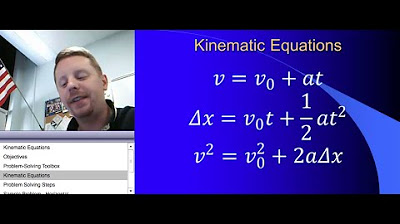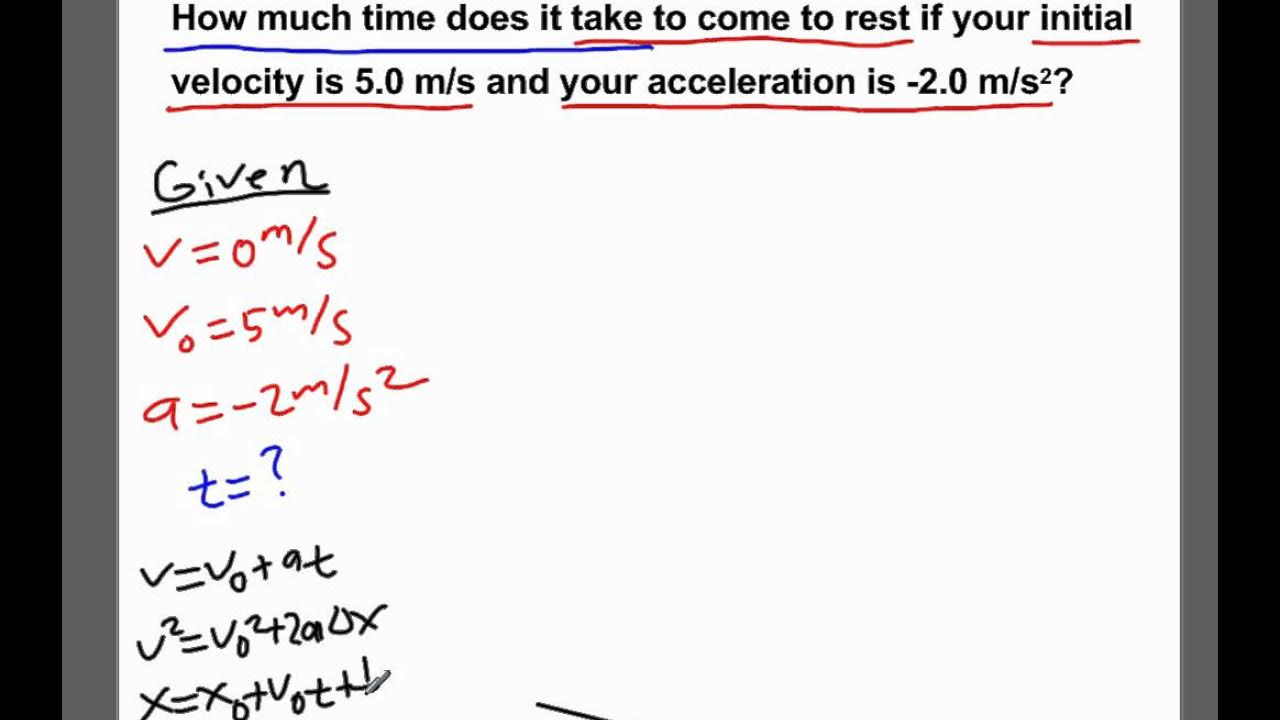Creating And Using Kinematic Equations Chart - Kinematics - Physics
TLDRThis video tutorial teaches viewers how to create a kinematics equation chart to solve various kinematic problems efficiently. It introduces the five fundamental kinematic variables: displacement (Δx), initial velocity (v_i), final velocity (v_f), acceleration (a), and time (t). The video then presents four key kinematic equations and explains how to identify which equation to use based on the given and unknown variables in a problem. A practical example involving a car's acceleration and travel distance over time is used to demonstrate the application of the chart, guiding learners to quickly and accurately determine the displacement using the second kinematic equation.
Takeaways
- 📚 Understand the five kinematic variables: displacement (Δx), initial velocity (v_i), final velocity (v_f), acceleration (a), and time (t).
- 🧩 Create a kinematics equation chart to solve kinematic problems by identifying which equation to use based on given and unknown variables.
- 🔍 The first kinematic equation is v_f = v_i + a*t, which helps find the final velocity when initial velocity, acceleration, and time are known.
- 🔍 The second equation, Δx = v_i*t + 0.5*a*t^2, is used when you need to calculate displacement with initial velocity, acceleration, and time.
- 🔍 The third equation, v_f^2 = v_i^2 + 2*a*Δx, relates final velocity, initial velocity, and displacement without involving time.
- 🔍 The fourth equation, Δx = (v_i + v_f)/2 * t, is used when displacement, initial and final velocities, and time are given or needed.
- 💡 Identify the unnecessary variable for a problem by its absence in the equation, which will guide you to the correct kinematic equation to use.
- 🚗 Apply the kinematics chart to real-world problems, such as calculating the distance a car travels given its initial speed, acceleration, and time.
- 📝 Always write down the given and unknown variables, and use the unmatched variable to find the appropriate equation on the chart.
- 🔢 Substitute the known values into the chosen equation to solve for the unknown variable, following the principles of algebra.
- 📈 The kinematics chart is a valuable tool for quickly selecting the correct equation and solving a wide range of motion problems.
Q & A
What is the main purpose of creating a kinematics equation chart?
-The main purpose of creating a kinematics equation chart is to help determine which equation to use when solving a particular kinematic equation problem by identifying the given and unknown variables.
What are the five kinematic variables mentioned in the video?
-The five kinematic variables are displacement (ΔX), initial velocity (VI), final velocity (VF), acceleration (a), and time (t).
What is the first kinematic equation presented in the video?
-The first kinematic equation presented is VF = VI + at, which relates final velocity, initial velocity, acceleration, and time.
How can you identify which equation to use when solving a problem?
-To identify which equation to use, you should list the given and unknown variables, and then look for the equation where the unnecessary variable is shaded in the kinematics chart.
What is the significance of shading a variable in the kinematics chart?
-Shading a variable in the kinematics chart signifies that the variable is not needed to solve the problem, which helps in determining the appropriate equation to use.
What is the second kinematic equation and what variables does it involve?
-The second kinematic equation is ΔX = v_i * t + (1/2)a*t^2, involving displacement, initial velocity, acceleration, and time, but not the final velocity.
In the example problem about the car, what are the given values and what is being asked?
-In the example problem, the car has an initial speed (v_i) of 5 meters per second, accelerates (a) at 3 meters per second squared, and the time (t) is 5 seconds. The problem asks for the displacement (ΔX) the car travels during this time.
How is the displacement calculated in the example problem?
-The displacement is calculated using the second kinematic equation (ΔX = v_i * t + (1/2)a*t^2) with the given values: initial velocity (5 m/s), acceleration (3 m/s^2), and time (5 s), resulting in a displacement of 62.5 meters.
What is the final kinematic equation presented in the video, and which variables does it include?
-The final kinematic equation presented is ΔX = (1/2)(v_i + VF)*t, which includes displacement, initial velocity, final velocity, and time, but not acceleration.
How does the kinematics chart help in solving kinematic problems?
-The kinematics chart helps by providing a visual representation of the relationships between the kinematic variables in different equations. It assists in quickly identifying the correct equation to use based on the given and unknown variables, streamlining the problem-solving process.
What is the importance of understanding the relationships between the kinematic variables?
-Understanding the relationships between the kinematic variables is crucial for solving motion-related problems accurately and efficiently. It allows for the correct application of mathematical models to describe and predict the behavior of objects in motion.
Outlines
📚 Introduction to Kinematics Equation Chart
This paragraph introduces the concept of a kinematics equation chart, which is a tool to help solve kinematic problems. It explains the five kinematic variables: displacement (ΔX), initial velocity (VI), final velocity (VF), acceleration (a), and time (t). The paragraph then presents the four fundamental kinematic equations and emphasizes the importance of identifying which variable is not present in a given problem to select the appropriate equation for solving it. The process of elimination is introduced as a method to determine the correct equation to use based on the known and unknown variables.
🔍 Applying the Kinematics Chart to a Problem
In this paragraph, the speaker demonstrates how to apply the kinematics chart to a real-world problem. The example given involves a car accelerating from an initial speed of 5 m/s with an acceleration of 3 m/s² for a duration of 5 seconds. The goal is to find the displacement during this time. The paragraph explains how to identify the given and unknown variables, use the chart to find the correct equation (ΔX = v_i t + 1/2 a t²), and then substitute the known values into the equation to calculate the displacement. The final answer is 62.5 meters, illustrating the practical application of the kinematics chart in solving motion problems.
Mindmap
Keywords
💡Kinematics
💡Equation Chart
💡Displacement (ΔX)
💡Initial Velocity (VI)
💡Final Velocity (VF)
💡Acceleration (a)
💡Time (t)
💡Kinematic Equations
💡Problem Solving
💡Variable Identification
Highlights
Creating a kinematics equation chart is introduced as a helpful tool for solving kinematic problems.
Five kinematic variables are identified as displacement (ΔX), initial velocity (VI), final velocity (VF), acceleration (a), and time (t).
Four kinematic equations are presented, derived from previous videos, to relate the five variables.
The method of identifying the correct equation to use involves looking at the given and unknown variables and selecting the one with the unnecessary variable shaded in green.
An example problem is provided, involving a car with an initial speed of 5 m/s accelerating at 3 m/s^2 for 5 seconds, and the goal is to find the displacement.
The process of solving the example problem is demonstrated by writing down all variables, filling in known values, and using the kinematics chart to find the correct equation.
The second kinematic equation is used for the example, as the final velocity (VF) is the unnecessary variable, and the displacement (ΔX) is what is being sought.
The solution to the example problem is calculated by substituting known values into the selected kinematic equation, resulting in a displacement of 62.5 meters.
The video emphasizes the importance of understanding which variables are given and which are unknown to select the appropriate kinematic equation.
The kinematics chart is a visual aid that helps in quickly identifying the correct equation based on the provided and required information.
The video provides a clear and structured approach to solving kinematic problems, making it accessible for learners.
The practical application of the kinematics chart is demonstrated through a real-world scenario involving a car's motion.
The video content is designed to enhance problem-solving skills in kinematics and加深对物理定律的理解 (deepen the understanding of physical laws).
The use of the kinematics chart is promoted as an efficient method to tackle a variety of kinematic problems, showcasing its versatility.
The video concludes by reinforcing the steps to use the kinematics chart effectively, ensuring the viewer has a clear understanding of the process.
Transcripts
Browse More Related Video
5.0 / 5 (0 votes)
Thanks for rating:





